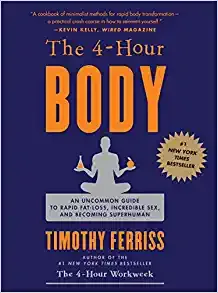10 Best Healthy Living and Wellness Books to Read in 2024
The 10 Best Health and Wellness Books to Read in 2024
1. How Not to Die
How Not to Die: Discover the Foods Scientifically Proven to Prevent and Reverse Disease by Dr. Michael Greger
I still agree with most of the views in the book, such as:
- Promote a balanced diet. Nutrients from whole vegetables are more effective than supplements. This seems more reliable than some books that let you take various supplements.
- Daily intake of various vegetables + whole grains + beans + potatoes + nuts to achieve a balanced diet has given me a basic understanding of a balanced diet, at least I will take it into account when buying vegetables and cooking.
- According to the traffic light eating principle, let us try our best to choose unprocessed or lightly processed food and avoid deep processing and junk food.
- The secret to staying healthy: a whole-vegetable diet + 90 minutes of moderate-intensity exercise every day. I admit that I am a person who is more self-disciplined and loves sports. Exercise brings me health, and the dopamine secreted makes me feel full and full throughout the day. Pleasure, of course, the need to cut out all animal foods and go vegan, I have my doubts. It will be judged after learning more nutrition knowledge in the future.
2. The 4-Hour Body
The 4 Hour Body: An Uncommon Guide to Rapid Fat Loss, Incredible Sex and Becoming Superhuman by Timothy Ferriss
The book can be divided into three parts:
- Chapters 1 to 6 discuss basic concepts;
- Chapters 7 to 18 talk about fat loss and muscle gain;
- Chapters 19 to 33 tell the author's various crazy experiments in various aspects.
And put forward 4 principles that make the body sculpting program successful:
- Know what you're doing and increase self-awareness.
- Like what you are doing, improve entertainment
- Turn what you're doing into a competition and increase your motivation.
- Make the plan small and specific, and avoid big and empty.
For fat loss, the authors propose the "Slow-Carb Diet"
- Don't eat all "white" carbohydrates
- Eat a fixed food repeatedly
- Don't eat or drink calories
- Don't eat fruit
- Take one day off a week.
For muscle building, the author lists 4 principles:
- Exhaust each group of contacts
- Use 5/5 beats
- Only practice 2-10 movements per workout
- Increase the recovery time according to the number.
3. Metabolical
Metabolical: The Lure and the Lies of Processed Food, Nutrition, and Modern Medicine by Robert H Lustig
- Medicine for chronic disease treats symptoms, not the disease itself
- You can diagnose your own biochemical profile
- Chronic diseases are not "druggable," but they are "floodable"
- Processed food isn’t just toxic, it’s addictive
- The war between vegan and keto is a false war—the combatants are on the same side
- Big Food, Big Pharma, and Big Government are on the other side
4. Atomic Habits
Atomic Habits: An Easy & Proven Way to Build Good Habits & Break Bad Ones by James Clear
The second point of view subdivides habit formation into four steps:
- Cue;
- Craving;
- Response;
- Reward.
5. The Sleep Revolution
The Sleep Revolution: Transforming Your Life, One Night at a Time by Arianna Huffington
6. The Telomere Effect
The Telomere Effect: A Revolutionary Approach to Living Younger, Healthier, Longer by Dr. Elizabeth Blackburn
7. The Subtle Art of Not Giving a F*ck
The Subtle Art of Not Giving a F*ck: A Counterintuitive Approach to Living a Good Life by Mark Manson
8. The Little Book of Hygge
The Little Book of Hygge: Danish Secrets to Happy Living by Meik Wiking
Denmark's "National Wine" Carlsberg
Enthusiastic host
Newport near Christmas
"Frigid" subway
9. Born to Run
Born to Run: A Hidden Tribe, Superathletes, and the Greatest Race the World Has Never Seen by Christopher McDougall
10. Spark Joy
Spark Joy: An Illustrated Master Class on the Art of Organizing and Tidying Up by Marie Kondō
Here is a list of Books on Health and wellness:
- Life Force: How New Breakthroughs in Precision Medicine Can Transform the Quality of Your Life & Those You Love
- Cleaning Up Your Mental Mess: 5 Simple, Scientifically Proven Steps to Reduce Anxiety, Stress, and Toxic Thinking
- How To Be Well: The 6 Keys to a Happy and Healthy Life
- Eat Right 4 Your Type (Revised and Updated): The Individualized Blood Type Diet® Solution
- Eat, Drink, and Be Healthy: The Harvard Medical School Guide to Healthy Eating
- Changing My Mind by Margaret Trudeau
- The Blue Zones Kitchen: 100 Recipes to Live to 100 by Dan Buettner
- Lifespan: Why We Age―and Why We Don’t Have To by David A. Sinclair
- The Whole-Body Microbiome: How to Harness Microbes―Inside and Out―for Lifelong Health by B. Brett Finlay and Jessica Finlay
- How Healing Works by Wayne Jonas, M.D.
- The Pretty Dish by Jessica Merchant
- The Healing Power of Essential Oils by Eric Zielinski, DC
- I’ve Been Thinking by Maria Shriver
- Zero Sugar Cookbook by David Zinczenko
- The 10-Day Belly Slimdown by Kellyann Petrucci, MS, ND
- The Healing Self by Deepak Chopra, M.D. and Rudolph E. Tanzi, Ph.D.
- Forest Bathing by Dr. Qing Li
- Run Fast. Eat Slow. by Shalane Flanagan and Elyse Kopecky
- This Naked Mind by Annie Grace
Book Recommender
LOOKING FOR MORE BOOKS TO READ?
Explore and find your next good read - Book Recommender for specific interests.
Discover ratings, reviews, summaries, and genres from Google Books.
Get Book Suggestions















